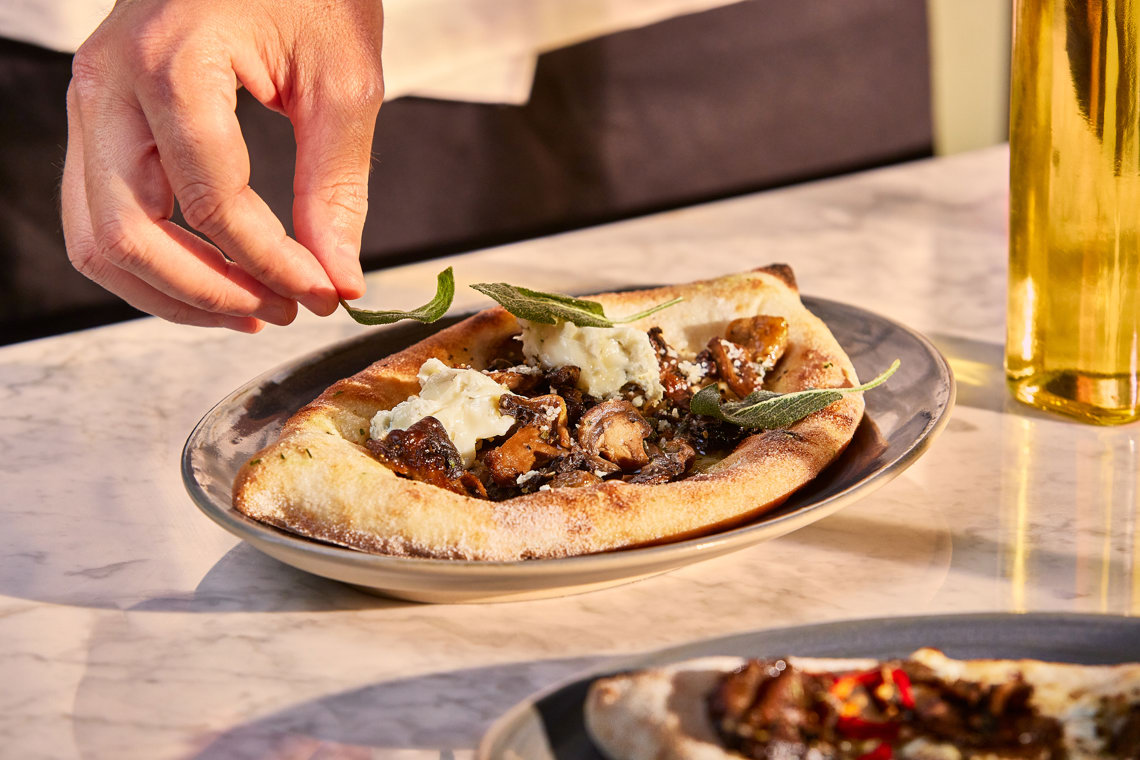Italian cuisine stands as a monument in the global food industry, renowned for its rich flavours, diverse ingredients, and its remarkable ability to transform simple meals into exquisite culinary experiences. This illustrious reputation is not without reason; Italian cooking emphasizes the quality of ingredients, the art of balance, and the importance of time-honoured traditions. From the bustling streets of Rome to the serene landscapes of Tuscany, the essence of Italian cuisine has permeated every corner of the world, influencing cooking methods, restaurant themes, and the culinary aspirations of chefs and home cooks alike. In this exploration, we delve into the heart of a traditional Italian kitchen, uncovering the key ingredients that are the backbone of its worldwide acclaim.
Key Ingredients of a Traditional Italian Kitchen:
1. Olive Oil
Described as the liquid gold of the Mediterranean, olive oil is fundamental in Italian cooking. It's used for sautéing, dressing salads, and as a finishing oil in many dishes. Its flavour ranges from fruity to robust, depending on the region of production. Dishes like Caprese salad and Focaccia bread showcase its versatility. In our house White Balsamic dressing, as well as to finish pasta creations such as Crab & Lobster Ravioli, olive oil plays a key role, epitomising its adaptability and essential role in Italian cuisine.

2. Garlic
Garlic adds depth and aroma to Italian dishes, acting as a flavour foundation in sauces, meats, and soups. Its use is varied – from raw and powerful in a bruschetta topping to subtle and sweet when roasted whole. Garlic is essential in dishes such as Aglio e Olio pasta and Chicken Cacciatore. Incorporated into our signature garlic bread and employed as the final touch for our calzones, garlic plays an essential role in enhancing the authenticity and flavour of our Italian dishes.
3. Tomatoes
Introduced to Italy in the 16th century, tomatoes quickly became a staple. From sun-ripened fresh varieties to rich, concentrated pastes, tomatoes are used in sauces, salads, and sun-dried as a condiment. They're central to classics like Margherita pizza and Marinara sauce. We use Mutti tomatoes for our pizzas and pastas, while incorporating a delightful array of mixed varieties for our bruschettas and salads..
4. Basil
This aromatic herb is synonymous with Italian cuisine, offering a sweet, peppery flavour that complements a wide range of dishes. Basil is the star of Pesto Genovese and a key ingredient in Tomato Basil soup, embodying the fresh, herbal quality of Italian cooking. The meticulous addition of five basil leaves, carefully positioned before our Margherita pizza enters the oven, is the secret behind why ours stands out as the finest.
5. Parmigiano Reggiano
Affectionately known as the "King of Cheeses," Parmigiano Reggiano adds a sharp, umami flavour to pastas, risottos, and salads. Aged for at least 12 months, it’s grated over dishes like Spaghetti Carbonara and used in the filling of Cannelloni. We freshly grate Parmigiano Reggiano at the table for every guest's enjoyment.

6. Balsamic Vinegar
Originating from Modena and Reggio Emilia, balsamic vinegar adds a sweet, tangy contrast to dishes. It's used in reductions, vinaigrettes, and to drizzle over vegetables. Caprese salad and Strawberry with Balsamic Vinegar are examples of its application. As with olive oil, we use Balsamic Vinegar as the finishing touch in many of our dishes.
7. Mozzarella Cheese
Famous for its soft, stretchy texture, Mozzarella is a staple in Italian kitchens. Made from cow or buffalo milk, it’s best enjoyed fresh. It’s the key cheese in Caprese salad and the beloved Margherita pizza. We employ both low and high water content varieties of mozzarella to achieve the pinnacle of perfection in our pizzas.
8. Pasta
Pasta is perhaps the most iconic of Italian ingredients, with shapes and sizes varying by region. It serves as the base for countless dishes, from simple Aglio e Olio to complex Lasagne Bolognese, showcasing the diversity of Italian sauces and preparations. We meticulously select from a wide array of pasta options, including fresh and dried, long and short, filled and folded, and so much more, ensuring an unparalleled dining experience.

9. Risotto Rice
Arborio and Carnaroli rice varieties are essential for making risotto, a creamy, comforting dish. These grains absorb liquids and flavours while maintaining a slight chewiness. Mushroom Risotto and Seafood Risotto highlight the versatility of this ingredient. We pay homage to risotto rice through our delectable arancini.

10. Anchovies
These small, salty fish pack a punch of flavour and are often used to add depth to dishes. Anchovies are key in Puttanesca sauce and are also used in dressings and as a pizza topping, demonstrating their strong, umami character. We utilise anchovies to craft our flavourful salsa verde and offer them as an optional addition to enhance our pizzas further.
11. Prosciutto
This dry-cured ham, originating from Italy, is thinly sliced, and served uncooked. It adds a savoury depth to a variety of dishes, from appetizers like Prosciutto e Melone to being wrapped around grissini or laid atop a freshly baked pizza. Its salty, rich flavour also complements the sweetness of fruits and the creaminess of cheeses, showcasing its versatility.
12. Polenta
A staple of Northern Italy, polenta is made from ground cornmeal and cooked into a comforting, creamy consistency. It serves as a base for rich meat sauces and stews or can be cooled and sliced for grilling or frying. Polenta provides a rustic, earthy backdrop to dishes such as Polenta con Salsicce (polenta with sausages) and Polenta e Funghi (polenta with mushrooms).
13. Ricotta Cheese
This creamy, mild cheese is made from the whey left over from the production of other cheeses. Ricotta is incredibly versatile, used in both savoury and sweet dishes. It's the heart of traditional lasagne, adds lightness to ricotta gnocchi, and is a key filling ingredient in Cannoli, blending seamlessly with flavours ranging from lemon zest to spinach. Ricotta cheese is an integral ingredient in our decadent Spinach & Ricotta Cannelloni.

14. Artichokes
Artichokes are a beloved ingredient in Italian cuisine, particularly in the spring. They can be grilled, stuffed, or used in pasta and risotto. Roman-style artichokes (Carciofi alla Romana) and Artichoke Risotto highlight this ingredient's unique, slightly nutty flavour that can stand out or complement other ingredients.
15. Sage
Sage is an aromatic herb with a slightly peppery flavour, used in Italian cooking to add depth to meat dishes, pastas, and bean soups. It pairs beautifully with butter to create a simple yet profound sauce for gnocchi or ravioli, exemplifying the Italian knack for marrying simplicity with elegance. We adore crispy fried sage, employing it to elevate the flavours of our pasta dishes and grilled specialties as a delightful finishing touch.

16. Cannellini Beans
These white beans are smooth and nutty, often featured in soups, salads, and stews. They're a key component of Ribollita, a hearty Tuscan soup, and are also mashed into a creamy spread for bruschetta, showcasing their versatility and ability to absorb flavours.
17. Saffron
Known for its vivid colour and distinctive flavour, saffron is a luxurious spice used sparingly in Italian cooking. It's most famously used in Risotto alla Milanese, imparting a golden hue and a unique aroma. Saffron also finds its way into a variety of seafood dishes, adding a touch of opulence.
18. Fennel
With its crisp texture and liquorice-like flavour, fennel is a popular ingredient in Italian salads, sausages, and braised dishes. It can be served raw, as in Insalata di finocchi e arance (fennel and orange salad), or cooked, becoming meltingly tender and sweet, as in Fennel with Parmesan.
19. Pecorino Cheese
Pecorino is a hard, salty Italian cheese made from sheep's milk, known for its bold flavour. It's used grated over pasta, incorporated into the dough of bread and pastries, or served with honey and fruits as a dessert. Pecorino Romano is a key ingredient in Cacio e Pepe, a testament to its central role in Italian culinary traditions.
20. Espresso
Last but not least, espresso is not just a beverage but an integral part of Italian culture and cuisine. It’s the culmination of a meal, a way to enjoy a break during the day, and a key ingredient in desserts like Tiramisu and Affogato al caffè, demonstrating its versatile role in both culinary and social traditions of Italy. We proudly serve Illy espresso in all our restaurants which also features in our affogato. High quality espresso is also used to craft the indulgent layers of our tiramisu.
The allure of Italian cuisine lies not just in its flavours but in the stories behind each dish, the quality of ingredients, and the passion of those who prepare it. These key ingredients form the foundation of Italian cooking, contributing to its fame and widespread appeal. Through the judicious use of olive oil, the rich tang of tomatoes, the aromatic presence of basil, and the unmistakable umami of Parmigiano Reggiano, Italian cuisine has captivated the palates of people around the globe. Each ingredient plays a crucial role, weaving together the tapestry of flavours, textures, and aromas that define this beloved culinary tradition. As these components come together in the hands of skilled cooks, they create dishes that are much more than the sum of their parts— they're expressions of culture, history, and the enduring power of food to bring people together. Italian cuisine's prominence in the global food scene is a testament to the timeless appeal of its core ingredients, each contributing to the rich mosaic of tastes that make Italian dishes not only highly sought after but deeply cherished.